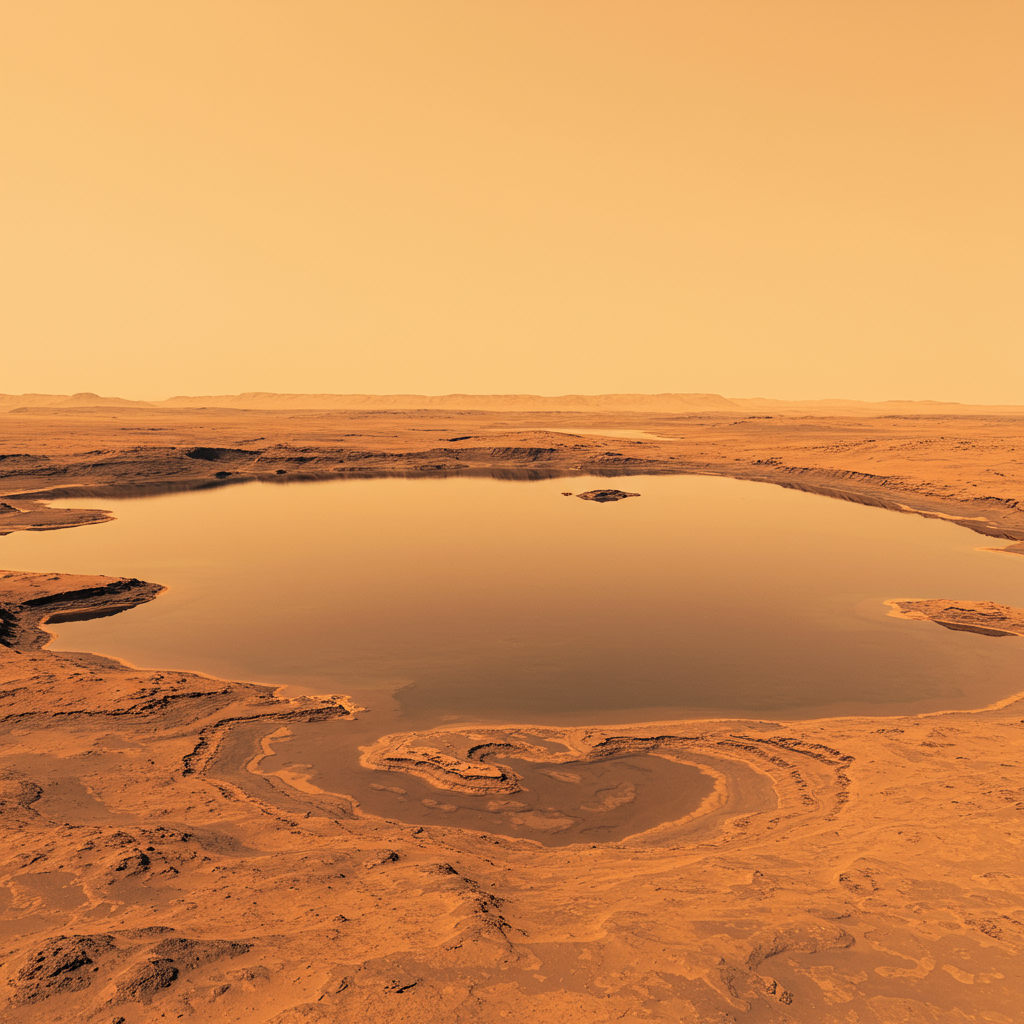Could ancient Mars have harbored life? A new study offers compelling evidence that widespread clay deposits on the red planet represent prime locations to search for traces of past microbial activity. these thick layers of clay, found across various regions of Mars, likely formed billions of years ago alongside stable, standing bodies of water like lakes. Scientists believe these environments could have provided ideal, long-lasting conditions for simple life forms, if they ever arose.
Understanding how these clays formed is crucial for identifying the most promising sites for future missions seeking biosignatures, the telltale signs of life. The findings, published by a team led by researchers at The University of Texas at Austin, highlight a previously unrecognized potential for long-term habitability in these ancient Martian landscapes.
Ancient Mars: A Wetter, More Earthlike World
Billions of years ago, Mars was dramatically different from the cold, dry desert it is today. Evidence from orbiters and rovers consistently points to a past characterized by liquid water, rivers, and potentially vast lakes or even oceans. The presence of water is considered fundamental for life as we know it.
Among the most significant geological indicators of this wetter past are minerals like clays and carbonates. These minerals form through the interaction of rock and water over long periods. The sheer scale and thickness of Martian clay deposits suggest prolonged exposure to water.
Why Clays Matter in the Search for Life
On Earth, clay minerals are renowned for their ability to preserve organic molecules and even fossilized microbes over geological timescales. The fine-grained structure and chemical properties of clays can protect delicate biological materials from decay and environmental degradation. This makes clay-rich rocks on Earth invaluable archives of our planet’s ancient biological history.
Given this Earthly parallel, scientists have long speculated that if life ever existed on Mars, clay deposits would be among the most likely places to find evidence of it. The minerals within clays, often rich in elements essential for life, could have also provided a suitable environment for microbes to thrive in the first place.
New Study Reveals Insights into Martian Clay Formation
A recent investigation spearheaded by The University of Texas at Austin focused specifically on the formation process of widespread, thick clay layers on Mars. The research team, including lead author Rhianna Moore and co-author Tim Goudge, examined data from approximately 150 known clay-rich sites across the planet. Many of these locations had previously been mapped in detail by instruments aboard NASA’s Mars Reconnaissance Orbiter (MRO).
Their analysis revealed a consistent pattern: most of the thick clay deposits are located near geological features interpreted as ancient lakebeds or areas associated with standing water. This strong spatial correlation suggests a direct link between the formation of these extensive clay layers and the presence of stable bodies of liquid water.
Clues from Earth Analogues
The Martian clay layers, some extending hundreds of feet deep, bear resemblance to thick clay sequences found in certain regions on Earth, particularly in humid, tropical environments. On Earth, such deposits typically form in areas with abundant water and minimal physical erosion. Erosion can strip away weathered rock material before it can fully transform into clay.
The study’s findings propose a similar scenario for ancient Mars. Tim Goudge, an assistant professor at the Jackson School’s Department of Earth and Planetary Sciences, noted that the Martian sites exhibit characteristics consistent with low erosion rates, which helped preserve the deep clay layers as they formed. While direct evidence for ancient Martian humidity is harder to ascertain definitively from these deposits alone, the lack of significant erosion appears to be a key factor shared with Earthly counterparts.
Stable Environments for Sustaining Life
One of the most significant implications of the study is the suggestion that these clay-forming environments were not fleeting occurrences but potentially long-lasting, stable habitats. Rhianna Moore of the University of Texas’ Jackson School of Geosciences emphasized the stability observed in these regions.
These clay-rich areas near ancient water sources exhibit low topographic uplift. This means the terrain remained relatively undisturbed over time. A stable landscape is crucial for potential habitability. Frequent geological upheaval or rapid environmental shifts can disrupt delicate ecosystems and make it difficult for life to take hold and persist. Moore explained that stable terrain does not “mess up” potentially habitable environments, allowing favorable conditions to be sustained for longer durations.
This concept of stability distinguishes these clay-rich areas from other water-related features on Mars, such as transient river channels that might have existed for only brief periods. The presence of thick, extensive clay points towards conditions that persisted for considerable lengths of time, potentially offering ample opportunity for microbial life to evolve and flourish.
Martian Geology: Similarities and Key Differences
While the end result – thick clay layers formed in the presence of water – shows similarity between ancient Mars and Earth, the underlying geological processes reveal fundamental differences, particularly concerning plate tectonics. Earth’s crust is divided into massive plates that constantly move, exposing fresh rock to the surface through processes like volcanic activity and mountain building. This fresh rock interacts with water and atmospheric gases, including carbon dioxide, influencing climate and driving mineral formation like clays and carbonates.
Mars, however, appears to have never experienced plate tectonics on a global scale comparable to Earth. This lack of moving plates meant that fresh rock was not continuously brought to the surface to react with the environment. When ancient Martian volcanoes released large amounts of carbon dioxide into the atmosphere, creating a warmer, wetter climate conducive to clay formation, there wasn’t a widespread geological mechanism to efficiently sequester that carbon into rocks.
The Puzzle of the Missing Carbonates
This geological difference could help explain a long-standing mystery on Mars: the relative scarcity of extensive carbonate rock deposits. Given the evidence for a thick, CO2-rich atmosphere and liquid water in the past, scientists predicted that large amounts of carbonates should have formed, much like they did on Earth (think of limestone). However, widespread carbonate formations have been challenging to find on Mars.
The lack of freshly exposed rock dueibute to the difficulty in forming extensive carbonates. Furthermore, the study’s authors suggest that the ongoing formation of vast clay deposits might have further contributed to this puzzle. As clays form, they effectively lock up water and various chemical byproducts within their structure. This process could have limited the availability of water and necessary ions leaching into the wider environment, thus hindering the chemical reactions required to precipitate widespread carbonate minerals. As Moore noted, it’s likely one of several factors contributing to the “weird lack” of predicted carbonates.
However, it is worth noting that the picture is still evolving. As highlighted in a separate report from April, NASA’s Curiosity rover recently discovered unexpectedly rich deposits of carbonates within Gale crater. This finding suggests that carbonates might indeed be more prevalent in specific localized areas on Mars than previously thought, potentially hidden or concentrated in ways scientists are still working to understand.
Implications for Future Missions
The new understanding of how and where these thick clay layers formed has direct implications for the ongoing and future exploration of Mars. Missions like NASA’s Perseverance rover and the European Space Agency’s Rosalind Franklin rover (part of the ExoMars program) are specifically targeting ancient, water-rich environments known to contain clays and other minerals indicative of past habitability.
Sites with thick clay deposits, formed alongside stable lakes, represent prime candidates for searching for preserved organic molecules or even microbial fossils (biosignatures). These locations offer the best chance of finding not only evidence that water was present but also evidence that conditions were stable enough, for long enough periods, to potentially support life. The findings of this study provide valuable guidance for selecting sampling locations for potential return to Earth in the future, where sophisticated laboratory analysis could reveal definitive proof of ancient Martian life, if it exists.
Frequently Asked Questions
Why are clays on Mars considered important for finding life?
Clays are significant because they form in the presence of water, a key ingredient for life as we know it. More importantly, on Earth, clays are excellent at preserving organic molecules and traces of ancient life over millions or billions of years. If life existed on Mars, its biosignatures might be trapped and protected within these ancient clay layers, making them prime targets for exploration.
Where are the significant clay deposits located on Mars?
Thick, widespread layers of clay are found in many regions across Mars. A study involving data from 150 known deposits revealed that most of these extensive clay sequences are situated near geological features identified as ancient lakebeds or areas where stable, standing bodies of water existed billions of years ago. NASA’s Mars Reconnaissance Orbiter has helped map many of these promising locations, often found within large ancient basins.
What does the formation of Martian clays reveal about the planet’s history compared to Earth?
The formation of thick Martian clays alongside ancient lakes indicates a past with significant liquid water, similar to early Earth. However, the study suggests differences arising from Mars’s lack of plate tectonics. Unlike Earth, Mars didn’t have a continuous supply of fresh rock reacting with its atmosphere. This difference likely influenced how minerals like clays and carbonates formed and were distributed, potentially contributing to the relative scarcity of widespread carbonates compared to what might be expected.
Conclusion: Clays as Windows into Mars’ Past
The recent study on Martian clays paints a vivid picture of ancient Mars as a world that could have sustained life. The presence of thick, widespread clay deposits, formed in conjunction with stable bodies of water like lakes, suggests that parts of the planet offered not just transient wet conditions but potentially long-lived habitable environments. These findings reinforce the scientific focus on clay-rich regions as the most promising places to search for evidence of ancient microbial life. As future missions continue to explore the red planet, locations identified by studies like this will be critical targets in humanity’s ongoing quest to answer one of the most profound questions: Are we alone in the universe?
Word Count Check: ~1150 words




